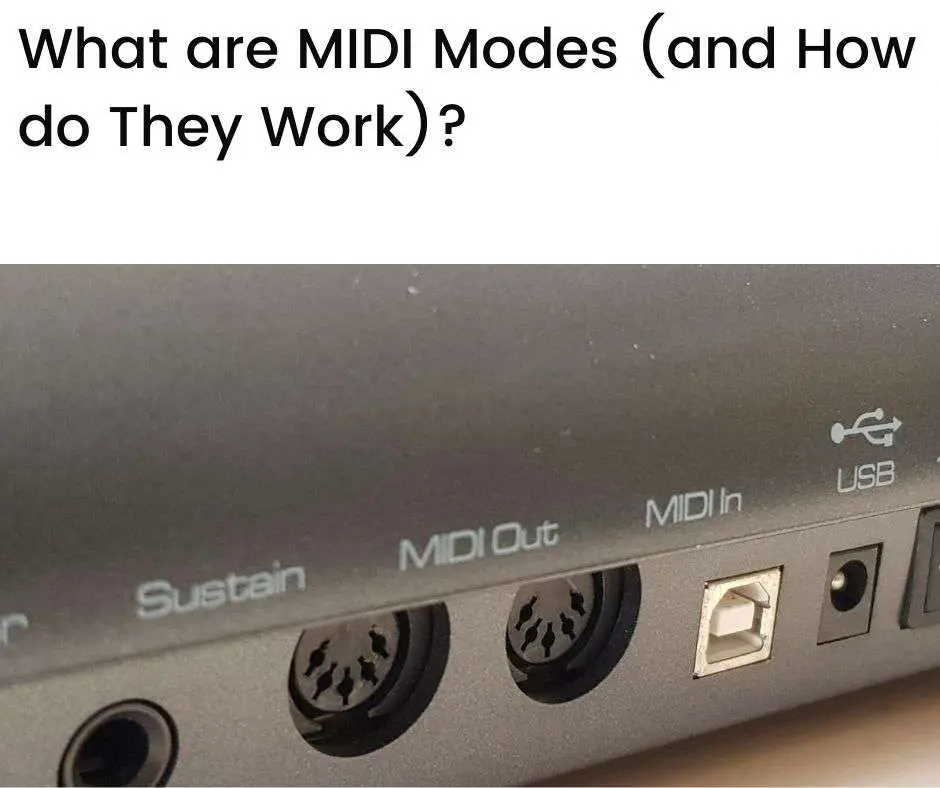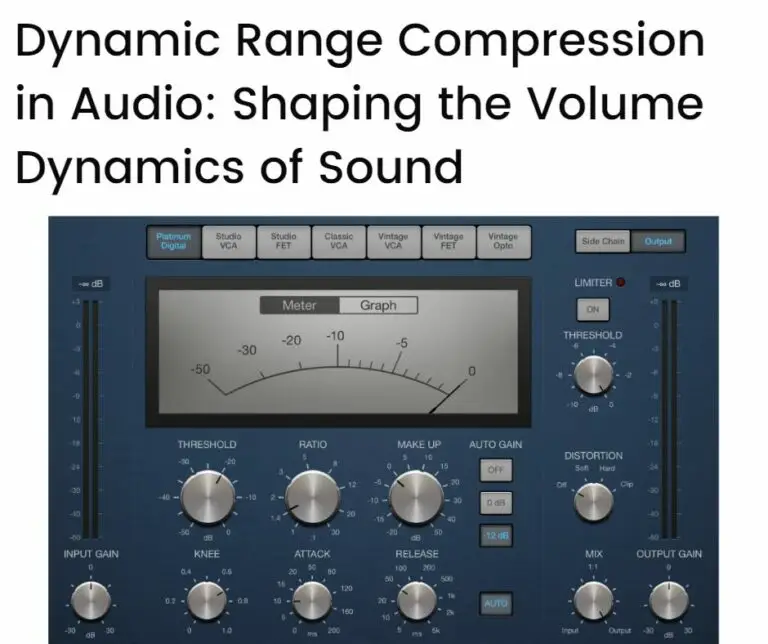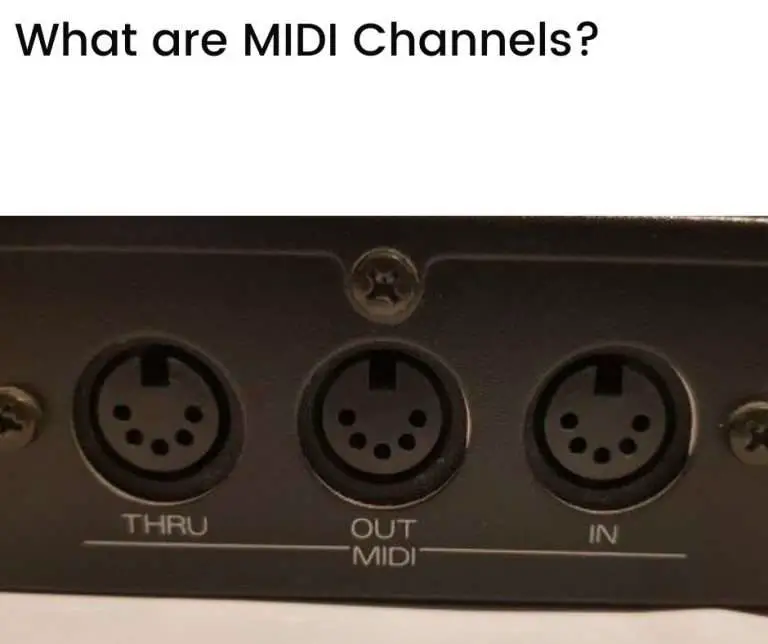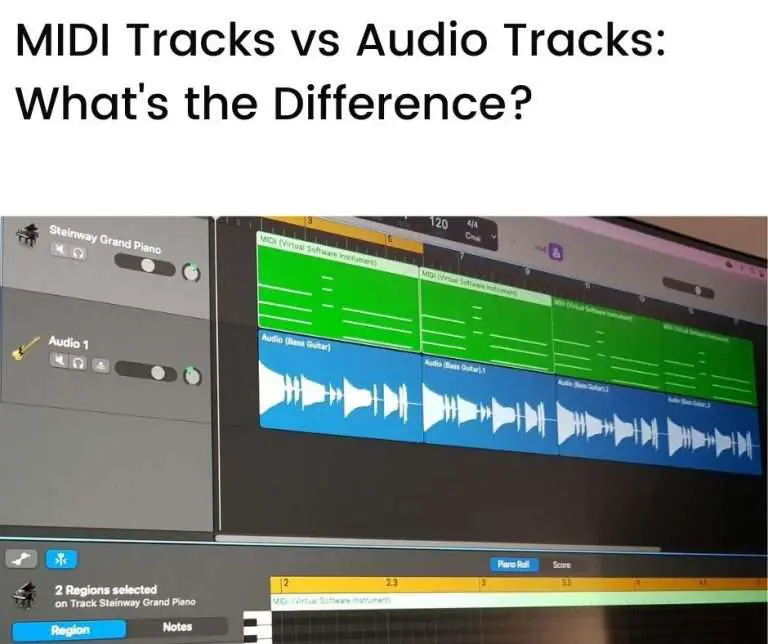MIDI modes are settings that control the way that MIDI instruments communicate with each other. They are grouped by the characteristics of MIDI instruments—monophonic or polyphonic—and by MIDI channel assignments. There are four original MIDI modes and two additional modes that were developed for enhanced functionality. MIDI modes offer a versatile way of organizing MIDI instrument arrangements.
In this article we’ll look at:
- What is MIDI?
- What are MIDI modes and what do they do?
- The MIDI modes
- What is the most commonly used MIDI mode?
- Conclusion
What is MIDI?
MIDI, or Musical Instrument Digital Interface, is a communication standard that allows devices to exchange performance data about sounds (ie. musical notes and chords).
MIDI was developed in the 1980s and was first used to communicate between MIDI-enabled electronic synthesizers.
Using MIDI, one synthesizer can send information about the notes and chords played by that synthesizer (only the performance information—MIDI data—not the actual sounds) to another device that can generate the sounds of those notes and chords.
MIDI communicates between devices using MIDI channels—there are 16 MIDI channels available, based on the MIDI standard specification.
What are MIDI modes and what do they do?
MIDI modes are settings that control the way that MIDI instruments utilize, and interact with, the MIDI data that they transmit and receive through MIDI channels.
MIDI modes specifically cater for certain characteristics of MIDI instruments—the number of notes that they can play at a time—and the MIDI channel assignments that they can have—one MIDI channel, or all 16 MIDI channels.
To better understand how MIDI modes operate, let’s take a closer look at the characteristics and channel assignments of MIDI instruments.
Monophonic and polyphonic MIDI instruments
Musical instruments are categorized as either monophonic or polyphonic.
Monophonic instruments can produce only one note at a time. Examples include woodwind and brass instruments, such as the flute, saxophone, clarinet, trumpet, and trombone.
Polyphonic instruments can play more than one note at a time—often several notes. These include keyboard instruments such as the piano, harpsichord, organ, and clavichord.
When it comes to MIDI-enabled electronic instruments—MIDI devices or MIDI instruments—the same categorization applies.
Monophonic electronic instruments have circuitry that’s capable of producing only one note at a time, whereas polyphonic electronic instruments can generate 16, 32, or up to 64 notes at a time.
Given their ability to generate multiple notes, polyphonic electronic instruments can play both notes and chords. They can also generate more than one musical line playing simultaneously.
MIDI instrument voices
Some MIDI instruments can only generate a single type of sound at a time, referred to as a voice.
Examples of different instrument voices are the electric piano vs synth bass vs synth strings. Each of these sounds has different and unique characteristics, and that’s what defines their voice.
Instrument voices are also called timbres.
Even if an instrument is polyphonic, if it can only generate one voice at a time, then all the notes played will be of the same voice (or timbre). An example would be a chord played in the voice of (only) a piano.
In the early days of MIDI, many electronic instruments were of a single voice or timbre—they could only play one type of instrument at a time, eg. guitar, flute, or trumpet.
But as music technology developed over the following decades, many MIDI devices became multi-timbral.
Multi-timbral electronic instruments can generate, for instance, a piano, strings, trombone, and flute all at the same time—they can play a whole orchestra all at once. Each of these voices can also be independently controlled using parameters such as volume, modulation, and panning.
Nowadays, most MIDI instruments are multi-timbral.
Channel assignments
Using the 16 available MIDI channels, devices can specify which other MIDI devices they wish to communicate with. This is done through channel assignments.
Channel assignments designate which specific MIDI channels are used for communication between any two MIDI devices.
A master synthesizer could, for instance, transmit percussion information to a drum module through MIDI channel 10, and melodic information to an external sound module through MIDI channel 3.
The master synthesizer would then be able to generate percussive sounds by sending MIDI information to the connected drum module (channel 10), and generate melodic sounds by sending MIDI information to the connected sound module (channel 3). These different types of information would be sent separately and would not overlap (depending on the choice of mode—see later).
MIDI reception modes
To deal with these characteristics of MIDI instruments and channel assignment possibilities, guidelines were developed to help organize the way in which MIDI instruments interact with MIDI data.
A MIDI instrument may, for instance, be set up to respond to all 16 MIDI channels at once. Another instrument which is, say, polyphonic, may have all of its voices set up to respond to only one MIDI channel.
These guidelines have been translated to settings that help to assign MIDI instruments to MIDI channels in various ways, allowing for better control and utilization of the channels depending on each instrument’s characteristics.
These settings are called MIDI reception modes, or simply MIDI modes.
The MIDI modes
Four MIDI modes were developed as part of the original MIDI specification.
The four modes are grouped based on:
- Poly/Mono—MIDI instruments can be set to respond to MIDI data in either a polyphonic or monophonic manner. A Poly setting means that the instrument can play more than one note at a time, while a Mono setting will only allow the instrument to play one note at a time.
- Omni On/Omni Off—MIDI instruments can be set to respond to all MIDI channels at once or to only one channel. An Omni On setting means that a MIDI instrument will respond to all channel messages being received regardless of any channel assignments. An Omni Off setting means that a MIDI instrument will only respond to a single MIDI channel or a set of assigned channels (for multi-timbral instruments).
Let’s now look at what the four original MIDI modes are:
Mode 1—Omni On/Poly
In this mode, a MIDI instrument will—
- Respond to data being received on any MIDI channel
- Play notes polyphonically
A MIDI instrument in this mode will, therefore, play all of the MIDI data that it receives, regardless of channel assignments, in a polyphonic manner.
MIDI instruments can generally nominate a base channel, so in this mode all MIDI data (from any channel) will be re-directed to the instrument’s base channel.
This mode is rarely used in practice.
Mode 2—Omni On/Mono
In this mode, a MIDI instrument will—
- Respond to data being received on any MIDI channel
- Only play notes monophonically
As in Mode 1, a MIDI instrument will play all of the MIDI data it receives (regardless of channel), but can only play one note at a time.
This mode is also rarely used in practice.
Mode 3—Omni Off/Poly
In this mode, a MIDI instrument will—
- Only respond to data being received on a single MIDI channel, ie. the instrument’s base channel
- Play notes polyphonically
A MIDI instrument in this mode will ignore any MIDI data being received on any channel other than its base channel, allowing for channel discrimination, and can play several notes at a time.
This mode is the most commonly used mode, usually by MIDI keyboards (that are not functioning multi-timbrally).
Mode 4—Omni Off/Mono
In this mode, a MIDI instrument will—
- Only respond to data being received on a single MIDI channel, ie. the instrument’s base channel
- Only play notes monophonically
As in Mode 3, a MIDI instrument will ignore any MIDI data being received on any channel other than its base channel, and can only play one note at a time.
This mode is popular for MIDI guitar controllers, as MIDI data can be transmitted one note at a time (ie. monophonically) over six separate channels (ie. one MIDI channel per string).
Multi Mode and Mono Mode
In addition to the original specification, two extra MIDI modes have been developed to provide for multi-timbral operation (Multi Mode) and for better control of MIDI guitars (Mono Mode):
Multi Mode—This is an expanded version of Mode 3 that allows for multi-timbral operation. This mode allows a MIDI instrument to respond to several MIDI channels at once, each of them being polyphonic.
Mono Mode—This is an expanded version of Mode 4 that allows for six Omni Off/Mono channels to be used at once, one for each string of a MIDI guitar. This results in improved MIDI performance data that caters for the dynamics of guitar playing, such as allowing independent pitch bends and separate sound assignments per channel.
Summary of the MIDI modes
The MIDI modes are summarized in the table below:
| MIDI Mode | Description |
|---|---|
| Mode 1—Omni On/Poly | MIDI instrument will respond to data being received on any MIDI channel, and can play notes in a polyphonic manner (several notes at a time)—rarely used |
| Mode 2—Omni On/Mono | MIDI instrument will respond to data being received on any MIDI channel, but can only play notes in a monophonic manner (one note at a time)—rarely used |
| Mode 3—Omni Off/Poly | MIDI instrument will only respond to data being received on a single MIDI (base) channel, allowing channel discrimination, and can play notes in a polyphonic manner (several notes at a time)—most commonly used mode, usually by keyboards (not functioning multi-timbrally) |
| Mode 4—Omni Off/Mono | MIDI instrument will only respond to data being received on a single MIDI channel (base) channel, allowing channel discrimination, and can only play notes in a monophonic manner (one note at a time)—often used for MIDI guitar controllers |
| Multi Mode | An expanded version of Mode 3—MIDI instrument can respond to several channels at once, each of them polyphonic—allows for multi-timbral operation |
| Mono Mode | An expanded version of Mode 4—MIDI instrument can use six Omni Off/Mono channels at the same time—improved MIDI data transmission for guitar playing |
What is the most commonly used MIDI mode?
As mentioned, Mode 3 is the most commonly used MIDI mode. But why is this the case?
In Modes 1 and 2, MIDI devices will respond to data being received on any MIDI channel, without regard to any channel designations that have been set.
This means that the device will play back all of the MIDI information being received, either polyphonically (Mode 1) or monophonically (Mode2). It cannot discriminate between channel assignments.
The resulting playback could be quite “muddled” in terms of the musical information being received without regard for their separate instrument and channel assignments.
The possible uses for Modes 1 and 2 are, therefore, quite limited.
Mode 3 is far more versatile, allowing channel discrimination and polyphony. Hence, only data that is intended for a particular channel will be recognized by a MIDI device and multiple notes can be played.
This versatility is the reason why Mode 3 is the most commonly used mode.
Mode 4, as described, is useful for MIDI guitar controllers. But these are less common than keyboard and other types of MIDI controllers.
The newer modes—Multi Mode and Mono Mode—are also quite versatile and are used by many MIDI devices.
Conclusion
MIDI modes are settings that allow MIDI devices to organize the way in which they communicate with each other.
MIDI modes are grouped by MIDI instrument characteristics (monophonic or polyphonic) and MIDI channel assignments (all channels or a single channel).
There are four original MIDI modes:
- Mode 1—Omni On/Poly—allows MIDI data over any MIDI channel in a polyphonic manner
- Mode 2—Omni On/Mono— allows MIDI data over any MIDI channel in a monophonic manner
- Mode 3—Omni Off/Poly— allows MIDI data over a single MIDI channel in a polyphonic manner
- Mode 4—Omni Off/Mono— allows MIDI data over a single MIDI channel in a monophonic manner
In addition, two additional MIDI modes have been developed:
- Multi Mode—an expanded version of Mode 3 that caters for multi-timbral operation
- Mono Mode—an expanded version of Mode 4 that caters for enhanced MIDI guitar controllers
Mode 3 is the most commonly used mode due to its versatility in allowing channel discrimination and polyphony. The newer modes, however, are also popular and used by many MIDI instruments.







